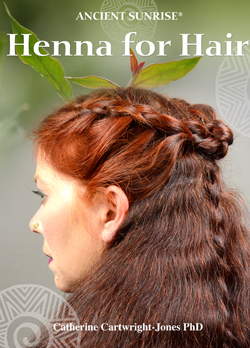|
Allergic reactions to pure henna are very rare.
Allergic reactions to adulterants, contaminants, and additives to henna are common. A few people have an itchy scalp after using henna, and this is usually caused by one of three things:
There have been only a few reports of Type I, IgE-mediated allergic reactions to pure henna. This allergic reaction includes a tight feeling in the chest, sneezing, itchy eyes, runny nose, and a dry cough. The onset is soon after the person is exposed to henna powder or paste. If you think you might be allergic to henna, dab henna on your forearm and wait one hour. If you do not have the symptoms above within that hour, you are not allergic to henna. If there is an orange mark on your skin from the henna, don't worry. That's the henna color staining your skin, and that's what it's supposed to do, and that's harmless! It is very unusual for a person who is allergic to PPD in synthetic hair dyes to also be allergic to henna. |
If you think you are allergic to hair dye, read Ancient SunriseŽ Chapter 1 Henna for Hair Introduction and the Epidemic of Para-phenylenediamine Sensitization  This chapter discusses the risks of using chemical hair dye, and the epidemeology of millions of cases of hair dye allergy. This chapter introduces the solution for allergies to chemical hair dye and associated chemical sensitivities. Index of specific topic pages in this chapter: Page 3: Ancient SunriseŽ Henna for Hair: Foreword Henna is NOT black Mapping the use of ‘black henna’ temporary tattoos Page 9: The epidemic of PPD sensitization and the urgency of using pure henna Page 18: Stylists and PPD Sensitization Page 20: Appendix I: Cross Sensitizations to Para-Phenylenediamine Page 21: Appendix II: Incidents If you get body art quality henna from mehandi.com, you can be certain that your henna does NOT have PPD or metallic salts in it! We send our henna to be tested at an independent laboratory to make certain it is absolutely pure. The countries who produce pre-mixed henna for hair dye often have lax regulations regarding cosmetic ingredient labeling, so do not have to list their ingredients. If a US company imports pre-mixed henna hair dye from another country, they can repackage and resell it with that inaccurate and misleading labeling. If you have a reaction to a pre-mixed henna for hair, you may be allergic to an unlisted ingredient, such as metallic salts, another plant powder, or PPD. |
| References: Bohlar, Mulder, and van Ginkel, IGE mediated allergy to Henna Allergy, Vol 56, Issue: 3, March 1, 2001, pp. 248 Marjoie, and Bruynzeel Occupational immediate-type hypersensitivity to henna in a hairdresser American Journal of Contact Dermatitis 1996;7: 38040 Pepys, Hutchcroft, Breslin Asthma do to inhaled chemical agents - persulphate salts and henna and hairdressers Clinical Allergy, 1976; 6: 399-404 Starr, Yuringer, and Brasher Immediate type I asthamatic response to henna following occupational exposure in hairdresser Annals of Allergy 1982; 48: 98-99 |
Type IV allergic reactions to PPD
occur up to 10 days after exposure, so a patch test is NOT definitive in
determining synthetic hair dye allergy. Even if you have
not had a
reaction to hair dye before, the probability of sensitization increases
with use. Synthetic hair dye allergic reactions include
blistering,
edema, rashes, itching, hair loss, and rare complications including
death.
See: Allergies to
Synthetic
Hair
Dyes: Para-Phenylenediamine
for medical papers detailing allergic and fatal reactions to PPD in
commercial hair dye. If you think you might be allergic to oxidative hair dye, please ask your physician for a diagnosis. Oxidative hair dye allergies are common and may be fatal if ignored. |
|
Allergic Reactions to "Black Henna" Temporary Tattoos
If you had a "black henna" temporary tattoo, and it itched or blistered, you are NOT allergic to henna. You had an allergic reaction to the para-phenylenediamine that was mixed into, or used instead of henna. If you ever had a "black henna" temporary tattoo, you probably should never use chemical hair dye again, because of the high probability of chemical sensitization and severe allergic reaction. Virtually all chemical hair dye has para-phenylenediamine or a derivative of PPD. You can, however, safely dye your hair with henna IF, and ONLY IF, you use pure henna. Insist on henna that is laboratory certified to be body art quality and free of contaminants, pesticides or adulterants. Henna from mehandi.com is laboratory certified to be free of PPD and other contaminants, and you should be able to use it with no problem. For more information on "Black Henna" allergic reactions, CLICK HERE |